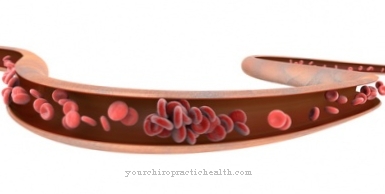A rupture of the patellar tendon is usually preceded by a reduction in the mechanical load-bearing capacity of the tendon tissue due to diabetes mellitus, microtraumatization and similar weakenings. Tissue is often removed from the patellar tendon to reconstruct the anterior cruciate ligament. A Rupture of the patellar tendon is noticeable through the noticeably upward shifted kneecap and the inability to straighten the knee joint.
What is a patellar tendon rupture?

© sakurra - stock.adobe.com
The patellar tendon (ligamentum patellae), which is more like a tissue band, connects the kneecap (patella) with the shinbone. Due to the short lever arm, when stretching from an extreme knee bend, she has to endure enormous forces of sometimes over 1,000 kiloponds per square centimeter. The ligament continues above the kneecap as a quadriceps tendon and connects to the powerful quadriceps femoris muscle.
When the knee is bent, the patella is used as a lever, so to speak. With a full Rupture of the patellar tendon power can no longer be transmitted from the quadriceps to the shin. When the thigh muscle is tensed, only the kneecap is pulled upwards.The upward displacement of the patella is also one of the main indicators that suggest a patellar tendon rupture.
A complete rupture of the ligament due to punctual overloading is rare. An avulsion is usually preceded by certain pre-existing conditions that have led to a gradual weakening of the patellar tendon. It is not uncommon for part of the patellar tendon tissue to be used to reconstruct the anterior cruciate ligament, so that a temporary weakening occurs.
causes
In principle, a patellar tendon rupture can occur as a result of punctual overloading - especially when the knee is in extreme flexion - or as a result of an externally inflicted injury. Previous damage to the patellar tendon tissue, which favors a rupture or even makes it possible in the first place, often takes the form of degenerative changes.
Specifically, it is, for example, diabetes mellitus or arterial occlusive disease (intermittent claudication) or a metabolic disease that chronically undersupplies and weakens the tendon tissue.
A patellar tendon rupture is also promoted by anatomical misalignments such as knock knees or different leg lengths. Patellar tendon ruptures mainly occur in people in the "second half of life" when the elasticity of the ligaments has decreased a little due to the natural aging process. A lack of exercise can also promote the disease, as the ligaments are not sufficiently used over a long period of time.
However, too much sport also has an unfavorable effect on chronic overloading of the patellar tendon, because it leads to microcracks, which promote chronic tendinitis, an inflammation of the patellar tendon. Athletes who frequently have to make abrupt changes of direction or who frequently overload the patellar tendon statically, as is the case with weightlifters, are particularly at risk.
Symptoms, ailments & signs
A patellar tendon rupture is accompanied by severe pain and a swollen knee, making a clear diagnosis difficult. The upward shifted kneecap can be seen as an important key symptom. However, a differential diagnosis should be used to determine whether it is a possible patellar fracture, which also leads to parts of the patella being elevated.
An equally important symptom is the inability to actively straighten the lower leg against the slightest resistance. This is due to the fact that if the tendon of the quadriceps is completely torn, there is no connection to the shin and thus no force can be transmitted in the direction of the extension of the lower leg. The severe swelling is caused by reactions of the immune system.
This allows all available forces to be used to repair the rupture, which of course cannot work in the event of a complete tear. The two ends at the torn area are wide apart and cannot connect again "by themselves". As a result of the swelling, the knee appears red and warmer than the surrounding tissue.
Diagnosis & course of disease
If the key symptoms of a patellar tendon rupture described above do not provide sufficient certainty about the type of injury, imaging procedures such as X-rays or, even better, magnetic resonance imaging (MRI) can be used. This is often necessary if, for example, it is not certain whether the tendon is torn or whether it is completely ruptured.
The further course of the disease depends very much on whether it is a tear, a partial tear, or a complete tear off of the tendon. In some cases it is difficult to diagnose precisely because the ligament does not usually tear smoothly, but rather frays and may still have a few fibers connected to one another.
In the case of a partial rupture, the patellar tendon can partially regenerate under favorable conditions, which is excluded in the case of a total tear. There are practically no forces that bring the two torn ends back together and fuse with one another.
Complications
In most cases, the rupture of the patellar tendon is very painful. These mainly occur on the knees and can lead to significant restrictions in the life and everyday life of the person concerned. In most cases, the knee can no longer be fully extended. The pain itself often spreads to other regions of the leg and can lead to significant restrictions there.
In the worst case, the tendon can also tear completely. The knee itself is usually swollen and reddened. It is possible that the affected person is also dependent on walking aids in everyday life due to the ruptured patellar tendon. The knee is also warmed up and it is not uncommon for those affected to suffer from a fever.
Patellar tendon rupture is usually treated with physiotherapy. There are no complications. However, the patient may also need an operation to restore full joint mobility. The patient's life expectancy is not affected by the patellar tendon rupture.
When should you go to the doctor?
If there is pain in the knee area after a fall or accident, there is cause for concern. If there are irregularities in the knee joint due to intense physical activity, this is also unusual and must be examined. A doctor is required in the event of swelling of the knee, changes in the appearance of the skin or a decrease in physical resilience. An examination is advisable as soon as there are unsteady gait, impaired locomotion and restrictions in general mobility. If the leg can no longer be loaded with its own weight as usual, a medical diagnosis is required.
Until a doctor is consulted, the affected knee should be relieved and pain medication should be avoided. If the person concerned suffers from dizziness, palpitations, disorders of consciousness or a loss of consciousness, there is a need for quick action. In these cases the symptoms lead to sequelae. These must receive immediate medical care so that they do not become life-threatening. In acute cases, a rescue service must be alerted.
Sudden changes in behavior, reddening of the knee and an internal warmth are further signs of a health disorder. If the pain extends into the lower leg, there is an injury that should be presented to a doctor as soon as possible. A doctor is required if the kneecap is displaced or if there are other optical changes in the skeletal system.
Treatment & Therapy
Treatment for patellar tendon rupture also depends on whether it is a complete tear or a tear. In the event of a tear, depending on the severity of the tear, special physiotherapy is recommended, which is usually combined with aqua aerobics to enable movements without strain. In parallel with physiotherapy, decongestants and pain therapy are also used as required. In the event of a complete demolition, surgery is required.
Various methods are available to reconnect the two ends of the torn patellar tendon or to implant a replacement tendon made from your own or donor material. In order to prevent the quadriceps from breaking down, the suture can be relieved through certain surgical procedures so that functional physiotherapy can be started early after the operation.
You can find your medication here
➔ Medicines for joint painOutlook & forecast
The prognosis of the patellar tendon rupture depends on the cause and the patient's cooperation in the healing process. In principle, the disease is curable. A full and permanent recovery is also possible.
If there is a complete tear of the tendon, surgery is required. Otherwise irreversible damage can develop and lifelong discomfort and pain can cease. If the procedure goes without any further complications, the patient will be accompanied by physiotherapy. In this, the person concerned learns how to perform the optimal movement sequences and can gradually improve his or her health. In this way, healing is achieved under optimal conditions.
If the tendon is torn, surgery is usually not necessary. Physiotherapy is nevertheless used to improve movement sequences and support the healing process. Better results are achieved if the person concerned carries out exercises they have learned independently outside of the therapy hours.
In addition, lifestyle is crucial for long-term development. An unhealthy lifestyle, obesity and incorrect exercise increase the risk of permanent disorders. The risk of developing secondary diseases also increases. Even if healing is achieved, the patellar tendon rupture can recur in the course of life. If the symptoms recur, the prognosis is unchanged.
prevention
Active measures to prevent a patellar tendon rupture consist in maintaining fitness through light exercise training and through light to moderate endurance sports. All stressed tendons and ligaments receive an incentive to maintain their strength and elasticity. Passive measures consist in avoiding punctual overstressing of the knee joint, especially as a result of strong flexion. Sports such as handball, hockey and volleyball should only be practiced with the necessary caution and caution at an advanced age.
Aftercare
With a patellar tendon rupture, in most cases there are only limited or few follow-up measures available. In the case of this disease, the person affected should therefore ideally consult a doctor at the first signs and symptoms so that there are no further complications or complaints that would reduce the quality of life of the person concerned.
A patellar tendon rupture cannot heal itself, so a visit to a doctor is always necessary. Most patients with this disease are dependent on the measures of physiotherapy or physiotherapy. The person affected can repeat many of the exercises at home in order to continue to alleviate the symptoms and increase the mobility of the body.
In some cases, however, surgical interventions are necessary to relieve the symptoms of the patellar tendon rupture. After such an operation, the person concerned should rest and take care of the body. Exertion or stressful physical activities should be avoided in order not to unnecessarily burden the body. Usually this disease does not reduce the life expectancy of those affected.
You can do that yourself
To reduce the symptoms, the person concerned can pay more attention to his own health. Gaining weight or being overweight should generally be avoided so that the joints, bones and tendons are not unnecessarily stressed. The body weight should be within the recommended BMI. In addition, light physiotherapeutic exercises are recommended after medical or professional consultation. Unilateral physical exertion should be avoided so that no further muscle or bone problems develop.
The diseased region must be relieved and sufficiently spared so that the healing process is not interrupted. The application of force or the carrying of heavy objects should be avoided as they contribute to a deterioration in wellbeing. Sports activities must be restricted or completely stopped until the knee has regenerated. Strong tension in the knee joint and the extensor muscles in the thigh can intensify the symptoms and have a negative effect on healing. The footwear used should also be optimized and adapted to current physical needs. Do not wear high-heeled shoes to prevent further symptoms.
The organism needs sufficient vitamins, trace elements and sufficient fluids for a quick recovery. A healthy diet is recommended to strengthen the immune system and consumption of nicotine or alcohol is not recommended.





.jpg)





















